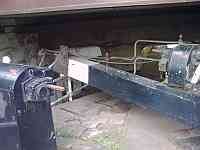
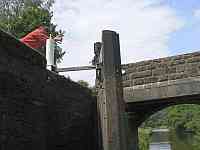
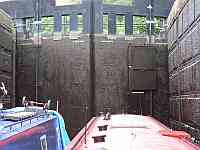
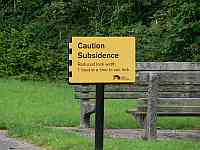
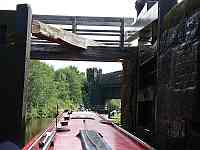
| Go to Allan's Page | Canals Home Page | Go to Deb's Page | ||
| Part 1. to Gloucester | Part 2: The Huddersfield Narrow Canal | Part 4: Home via Llangollen and Birmingham |
We had enjoyed our two trips across the Pennines by the Huddersfield Narrow Canal, and now we were ready for the hard work of crossing them twice more by the Rochdale canal. We just had a few domestic chores to complete before we left Dukinfield Junction, so while Debbie went to the launderette I did some hoovering. Our dogs had decided to start moulting incredible amounts of hair so some carpet cleaning was very necessary, but half-way through the task I realised that the hoover was slowing down. The reason was soon obvious: the alternator had stopped working so the batteries were going flat. We spent the weekend using as little electrical power as we possibly could, before being able to take the alternator into Portland Marina where they knew someone who could repair it. By the next day the alternator had been fitted with new electronics and was working fine back on the engine so we were ready to continue our journey.
The Ashton canal used to have a bad reputation for hooligans, and at one time you would be escorted along it by BW and the police, but the troublesome estates have been demolished and these days it is no worse than any other urban canal. We had a slow journey down the locks behind an elderly couple who were extremely slow, and a hire-boat who kept leaving the paddles open behind them and draining the pounds ahead of us. We still reached Manchester by lunchtime, and attempted to moor in Telford Basin at Piccadilly Village as we'd been advised; unfortunately the basin was too small for us, and although we could just get into it there was no way we could moor up, so we moored on some handy rings just outside the basin. We wondered if it would be a problem that we were moored outside someone's front window, but the flat-owner came out to chat to us and to check that we knew the security code for the gate so that we could get out to the rest of the world. We sat outside a pub in Piccadilly watching the rest of the world; well it felt that way, seeing so many people at the same time in the city all hurrying towards the station after work. We just sat and watched them, enjoying a few beers and then a curry, before returning to the boat and the quiet isolation of the canal world.
The next morning we turned the corner on to the Rochdale Canal, and met the BW staff who unlocked the bottom lock and helped us through it, Again, as with the HNC, the restoration had involved a number of unorthodox ways of operating the locks. I soon also realised that the water in the locks did not behave in the same way as in other wide locks that we are used to., but it took me some time to understand the differences so that we could fill the locks without the boat being swept from side to side. Unfortunately we were the only boat going up the locks out of Manchester that day, so we had to do all the work on our own and we found it very hard work. The locks were all against us at first but we knew that two boats were coming down, so at least I could leave the top gates open behind me while Debbie lock-wheeled, until we had met the other boats after which the locks were all ready for us with the bottom gates open (but we had to close the top gates behind us).
We completed the 19-lock climb out of Manchester in 6 hours, without getting any rubbish on the propeller or running aground apart from finding a pile of trolleys in the canal outside Morrisons, and met the same BW staff waiting at the top of the flight of locks to lock up behind us. That is not recommended as a good overnight stopping place however, and we carried on for another 90 minutes to find the 'Rose of Lancaster' public house. On the way we met a lift bridge, and when Debbie pressed the operating button I stared in amazement as the entire roadway lifted up into the air, staying flat and rising on four hydraulic rams to look like a giant brass bedstead! The Rose of Lancaster had a good mooring outside, and we enjoyed an excellent meal and some superb local beer (J W Lees beer comes in specially-shaped glasses that are easy to hold with less risk of being dropped; we liked that) before deciding to move another 200 yards to the pretty moorings by the aqueduct over the little river Irk for the night.
The next day was a day of slow and steady progress, It is certainly no good trying to plan a journey on the usual basis of 3 to 4 lock-miles per hour on this canal! Nearing Rochdale we met the horse-drawn boat Maria, towed by Bilbo under the command of Sue from the Horseboating Society. We held well out of their way as they came up behind us intending that Bilbo would cross the turnover bridge below Rochdale lock while pulling the boat in traditional fashion, before casting off the rope and loosing the boat into the lock. Unfortunately the rope snagged on a tree on the bridge parapet so they had to cast off early. We then joined them in the lock; when the lock was filled they gave us a demonstration how a horse-drawn boat, with its 'engine' on the towpath, could out-accelerate a motor boat every time and then outrun it in shallow or weedy water. We found it quite difficult to keep up with them. We followed them to Littleborough, where they were to stay for the following week's festival, and stayed there ourselves until the next morning when we were booked to cross the summit.
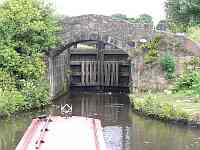 |
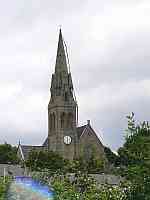 |
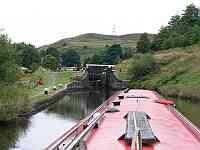 |
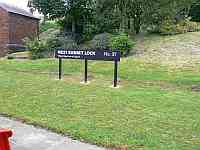 |
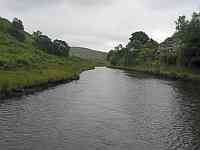 |
Many of the stone structures are highly attractive. |
Would you fancy climbing this? |
The scenery gets rugged as we approach the summit |
The summit at last! |
The summit is truly spectacular |
Leaving Littleborough we arrived at the start of the summit flight. There had been an excess of water all the way up the canal so far, but there is a severe shortage of water across the summit and in the few pounds either side; a legacy of the way the main reservoirs had originally been built well below the summit (the canal was originally planned to pass through a long tunnel instead of climbing to the summit) and of the way the water supplies from the remaining reservoirs had been sold to Manchester as a source of drinking water in the 1930's. The pounds ahead of us were all empty, and we would have to wait for BW to fill them; but someone in BW's office claimed that we had telephoned and cancelled our booked passage so they were not expecting us to arrive. As a result it was a couple more hours before we were able to proceed to the summit, but eventually we were able to complete the climb. We were joined by a couple of friends, who helped us work the locks and then unpacked an inflatable boat with which they followed us across the short but beautiful summit.
After descending from the summit, we found a beautiful mooring spot at Walsden, where our friends joined us for a barbecue. It was a marvellous evening but overnight it was cold wet and windy so they were very glad they had decided to stay on board keeping Up instead of camping on the towpath as they had originally intended!
Next we carried on down towards Todmorden. Passing the impressive 'Great Wall of Tod' we reached the rather unusual Todmorden lock. In many ways it resembles a river Nene lock, with water running over the top gates and an electrically operated guillotine for a bottom gate; but it differs in that it also has bottom paddles - manually operated and set into the guillotine. While emptying the lock I could keep the boat forward against the guillotine, but I still got quite wet from the water flowing over the gates behind me. I could see that the return trip could be quite difficult because I would have to keep the boat near the top gates while the guillotine was descending, and a lot of water would fall into the front cockpit area.
We carried on down the valley until we reached Sowerby Bridge. By now we felt that it was time to turn around so that we would not have to rush our return trip for our booked passage back over the summit, but first we needed to empty our waste tank. There is a BW pumpout facility at Sowerby Bridge, but we found that it was missing a vital component; BW said that a replacement had been on order for a month and was due to arrive the next day, but we didn't want to take a chance on that so we phoned the local boatyard, Bronte Boats. I cannot praise them enough; as well as running a fleet of hire-boats, they offer a first class mobile breakdown and repair service throughout the whole area including the whole of the Rochdale, Huddersfield, Leeds-Liverpool, and Bridgewater canals. The owner arrived to help us with a mobile pumpout machine, and while he cheerfully emptied our tank he explained that he couldn't waste any time because he was getting married less than 2 hours later!
So we made our way back up to Todmorden again, and stopped for the night outside the Golden Lion pub there which was advertising a Steak Night. We had the most fabulous 3-course meal there, for a price which would hardly have bought just a starter back home, accompanied by some excellent drinks. Looking at the lock we could see that we would have a big problem getting through the lock the next morning, as there was so much water pouring over the top gates that it would be impossible to wait in the lock; even with the front doors sealed up to protect the cabin, the quantity of water in the front well-deck would probably sink us. The only practical solution would be to lower the water level in the upper pound by opening the paddles at both ends of the lock for an hour or two, although that might flood the pound below so we would probably have to run some water through the lock below us as well. In the end, however, the level dropped overnight to about the same as it had been on our downward journey, and we were able to pass through the lock without the water being more than a couple of inches over the foredeck.
We quickly made our way up to wait just below the summit pound, and were joined by a hireboat who were booked to accompany us over the summit and down to Manchester. We were pleased at this because it would make the trip so much easier. The nest day we crossed the summit in fine weather, but had a problem in one lock when the (relief) lock keeper let us down into an empty pound and then asked the boat behind us to open the top paddles behind us and fill the pound. The rush of water propelled us out of the lock on to the lower cill, bending our skeg and rudder as it did so. For eighteen years we have been working locks on Keeping Up without damaging anything, and then British Waterways manage it for us! Fortunately the rudder still moved, albeit stiffly, so we were able to continue down to Littleborough, arriving there early and in fine weather so we decided to continue for a few more hours. The weather then got steadily worse, as it started to pour with rain and blow a gale, so we were glad when we reached the good moorings at Slattocks..
The weather was even wetter for our run down into Manchester. In company with the hireboat we had a fairly good trip down the locks, but we were all soaked by the time we moored at Piccadilly Village again. Of course, by then it had stopped raining! Anyway we walked into Manchester and celebrated our fourth crossing of the Pennines in just 3 weeks by having a fabulous banquet at a restaurant that I knew in Chinatown. Looking back we agreed that although the Rochdale Canal was the more spectacular canal of the two we were unlikely to make the effort to visit it again, whereas the Huddersfield Narrow Canal was almost as beautiful and was well worth visiting again even if we turned round before the tunnel.
After our hard work across the Rochdale and Huddersfield canals, averaging just over 4 miles a day for the last 3 weeks we felt like having a rest and then doing some lock-free cruising, but first we needed to finish our descent into central Manchester down the infamous 'Rochdale Nine'. We rejoined our hireboat companions from the last few days, to wait while two boats came up in the top lock, but were amazed when the crew of the two boats behind them started trying to close the gates in front of us. They insisted that they could not let us come down in the lock because there was not enough room in the next pound for us to pass them, but knowing that this was not true we insisted on coming into the lock. For several minutes as they closed one top gate we opened the other one alternately, then everybody had a lively discussion which eventually resulted in them agreeing that we could come down as the lock emptied. There was of course no difficulty in passing in the next pound and we carried on down the flight.
The locks were all quite difficult because of the amount of water flowing over the gates. Some of the boaters coming up made a great deal of fuss about the difficulty of operating the locks, although they were a lot easier than all the ones further up the canal; one boater for example sat in the lock tail and refused to try and open the bottom gates, instead telephoning BW to ask them to come to help and insisting that they must have some secret paddles somewhere that they could open to let the excess water go around the locks instead of over the gates; BW told them to stay where they were and do nothing, but we just carried on anyway without problems - and there was still no sign of anyone from BW long after we had departed.
Canal Street, where the horses used to use the road as the towpath, has finally fallen foul of the Health-and-Safety brigade. There are several pubs and restaurants on the opposite side of the street who have put chairs and tables along by the wall next to the canal. Apparently a number of people have discovered that if you have had enough alcohol that you can't resist dancing on the tables, and you fall off the table, you fall into the canal; as a result the council have decided that the street is unsafe so they are erecting 6-foot high glazed fencing along between the road and the canal. Apart from destroying the character of the canal, it will also make it impossible for lock-wheelers to reach the lock - but of course boaters' needs count for nothing in the face of Health & Safety.
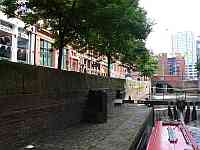 |
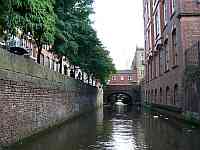 |
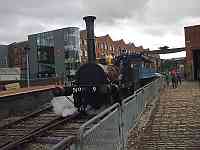 |
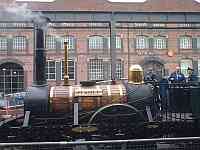 |
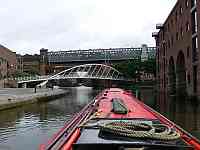 |
Canal Street won't look like this for much longer |
Manchester's Museum of Science and Industry has this wonderful engine |
Leaving Castlefield |
||
We decided to spend some time in Castlefield Basin. What a wonderful mooring this is; handy for the city yet totally secure as well as green and pleasant. There is a useful launderette in the YMCA, and just down the road is Manchester's Museum of Science and Industry which we found to be well worth a full day's visit, We could also have visited the Granada Studios from there, and in fact we met a couple of very well-known actors when we went into one of the pubs nearby, but after three enjoyable days we decided to leave Castlefield. We felt that this section of our 2009 trip was complete, and we were ready to move on to the last part of the trip.
| Part 1. to Gloucester | Part 2: The Huddersfield Narrow Canal | Part 4: Home via Llangollen and Birmingham | ||
| Go to Allan's Page | Canals Home Page | Go to Deb's Page |
All pictures on this site are © Allan Jones unless otherwise stated